



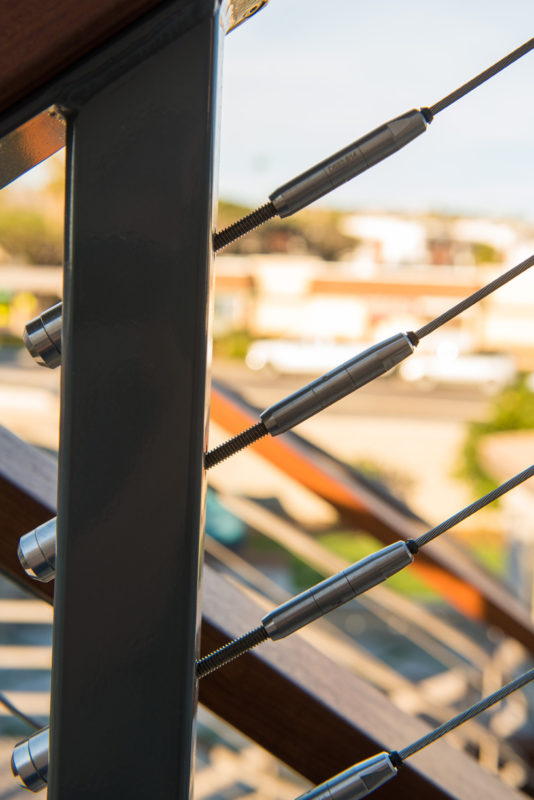
Utilizing Swageless Cable Railing Technology for Fast and Easy Installations A swageless cable railing fitting does not require and type of special tools, crimping or machinery. These fittings have become very popular with DIY installers and professionals for reasons of versatility and ease of installation. Often compared to “compression fittings” used in other industries, swageless fittings use a one way locking mechanism to secure the cable to the fitting. Stainless steel cable is allowed to enter the fitting in one direction while grabbing if pulled in the other direction. In the case that a cable is cut too long or the railing system needs to be dismantled for any reason; the fittings can also be released and re used. Swageless cable railing systems save installers time and money by eliminating the need for expensive machinery or crimping tools. The aesthetics are also improved by offering a wide variety of fitting choices without the visible marring that can be caused by field crimping. The strength of attachment provided by a swageless fitting can exceed the breaking strength of the cable itself, ensuring the safety and durability of the system. If you are a professional or DIY installer looking to construct a cable railing or fence, check out our DIY Cable Assemblies. SDCR do it yourself cable assemblies feature a machine swaged fitting and pre-cut length of cable combined with a swageless fitting for field installation. This combination saves time and cuts your installation cost while including all the necessary hardware. We offer fitting styles for surface mounting or thru post installations; with options for wooden and steel railng posts. SDCR cable assemblies are available in the two popular cable diameters; 1/8″ and 3/16″. They are perfect for deck rails, stairways and fences, as well as a variety of specialty architectural projects. If you have questions or would like pricing for a swageless cable railing system, please visit our quote request page or give us a call at 844-277-7327.
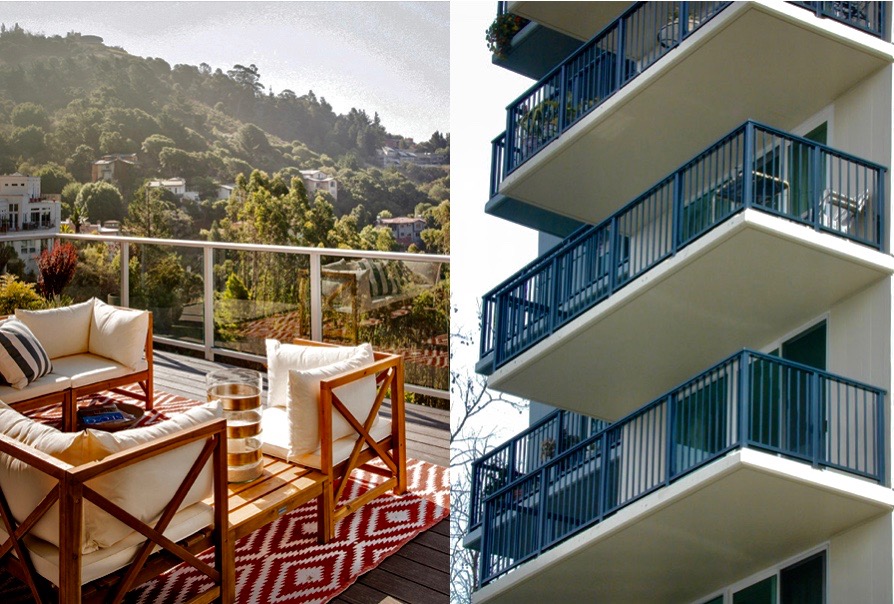
Selecting Alternative Infill Options for Aluminum Railing Systems Occasionally our customers have inquiries about building considerations that may require alternative options to stainless cable railing infill. For these situations our aluminum railing packages can offer versatility and code compliance at cost effective price points. Below is a list of alternative railing infill options as well as possible pros and cons for each option: Glass Panels- If a windbreak is needed, glass panels are a top choice among professionals. Tempered glass panels are shatter resistant and can be tinted or obscured if privacy is desired. A high quality tempered glass panel that is kept clean can provide a solid barrier with a completely unobstructed view. Pros– clear views, aesthetics, wind break Possible Cons– little fingerprints, maintenance Vertical Pickets- Preserving or matching existing aesthetics can be a common consideration at large complexes and home owners associations. For customers that need to match an existing look, aluminum picket railings can provide a low maintenance replacement to wood picket railings. Picket railings are easy to install and available in a variety of standard powder coat colors. Pros- widely recognized, availabilty, ease of install Possible Cons- obstructed views, traditional look Vertical Cables- Vertical cable systems have gained popularity in recent years. Although it is rare, some municipalities still prohibit the use of horizontal railing members. Vertical cables can be a great choice for customers who do not have the option for horizontal cable. Vertical cable railings feature the same clean lines and transparent views as horizontal cables. Pros– code compliance, aesthetics Possible Cons– cost, availability San Diego Cable Railings is an authorized distributor of Aluminum Design Rail Systems by Feeney. We can provide quotes for aluminum railing systems and installation by our preferred installers across California. If you have questions about any of the infill options discussed in this post, give us a call at 844-277-7327 or visit the quote request page.
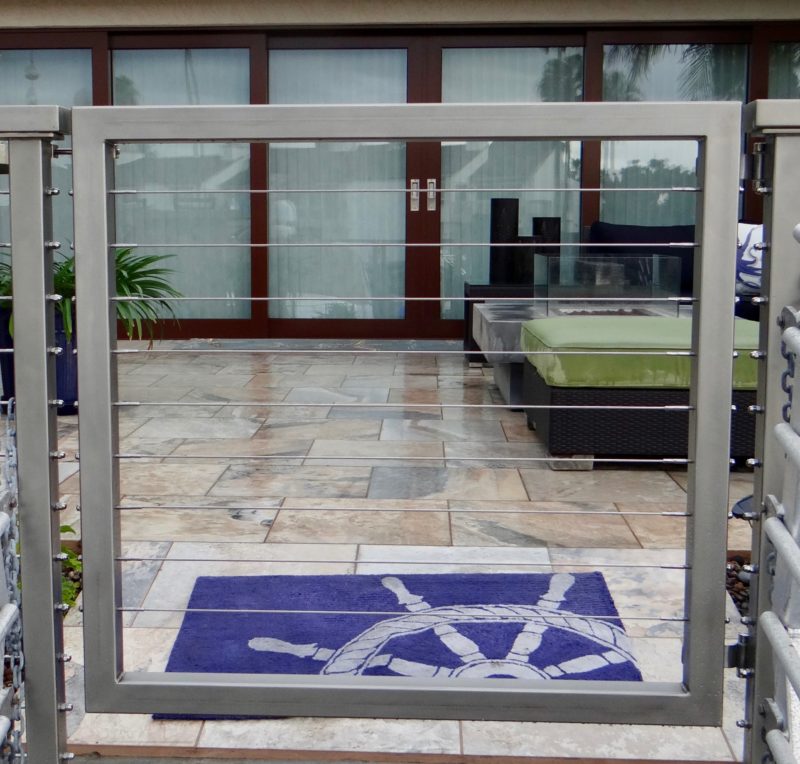
Custom Stainless Steel Gates With T316 Cable Infill If you’re looking for an alternative to standard wooden and iron gates; a stainless cable gate may be the answer. Cable railing gates provide the ability to create transparent access points for railings and fencing without drawing attention to the opening. A properly designed cable gate will blend into the existing framework and carry the same lines as the railing itself. Below are some frequently asked questions about our gates: Do cable railing gates sag? -No. Steel cable gates are extremely durable and they should never sag. Customers will not need extra brackets, wheels or wires in order to keep their gate hanging true. Our gates feature strength and dependability with welded stainless steel frames and high tension cable infill. Are cable gates code compliant? -Yes. Cable gates can be fabricated to code compliant height and width dimensions for standard 36″ and 42″ railings. For pool fencing applications, 60″ gates are also available. A 3″ cable spacing is used to assure that a 4″ sphere cannot pass through the cable infill. Can cable gates be mounted to walls or columns? -Yes. A cable gate can be mounted anywhere a standard gate would be used. Custom hardware is available for a wide variety of mounting applications. Questions about custom considerations can be submitted via the quote request page. Are cable gates available with wooden frames? -Yes. We have fabricated our gates from Ipe’, cedar and redwood with great success. Due to the tension cables a wooden cable gate is much sturdier than a standard wooden gate. Cable Railing Gates Will Keep Your Family and Pets Safe Safety is a top priority at San Diego Cable Railings and we are constantly working with our customers and installers to provide safety and beauty on all of our projects. If you have questions about cable gates or any of our products please give our pros a call at 844-277-7327.
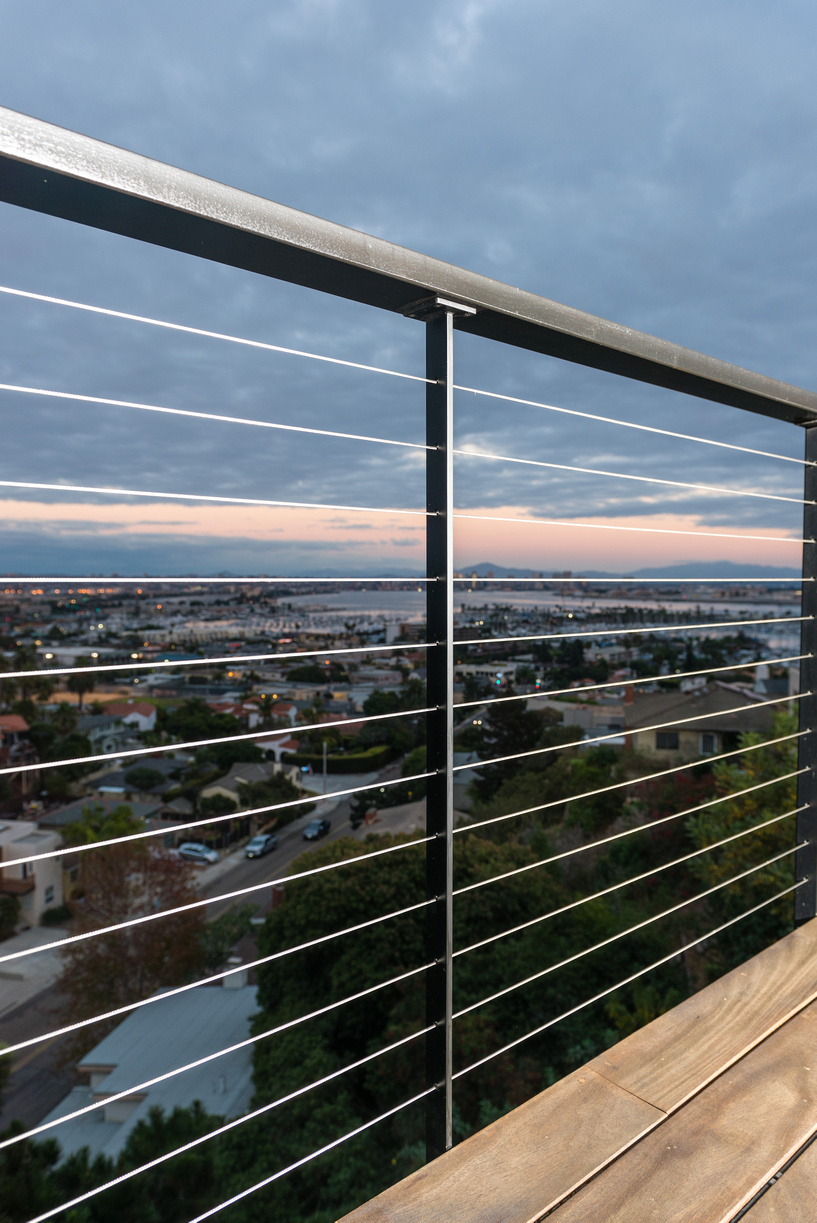
Selecting the Best Materials and Finishes For Extreme Durability There are several terms used in the steel fabrication industry to describe corrosion. We receive a few common questions from consumers about “oxidation”, “contamination” and the possibility or resistance our products will provide against “rust”. Maximizing corrosion resistance is about understanding the different terminologies and taking preventative measures to protect your investment. All metals have the potential to “oxidize”; while certain metals like t316 stainless steel provide a much greater resistance to all types of corrosion and oxidation. Surface Contamination- Probably one of the leading causes of staining and/or oxidation is surface contamination. Contamination is not rust. This term is used to describe the build up of some sort of debris on the surface of metal. Animals, trees, bushes and irrigation are some possible causes of surface contamination. Attempting to clean metal with the wrong chemicals, or using steel wool on stainless steel or aluminum can also cause contamination. Stains from these sources are often confused with corrosion or “rust” however this is not always the case. Any build up of contaminants on the surface of exterior metal can cause staining. Prevention- Maximizing corrosion resistance is about preparation. There are several good ways to prevent contamination and maximize the life of your exterior structures. Coatings are a great way to add longevity to stainless steel and aluminum railings, while providing a protective layer that cleans easily. Exterior grade paints, epoxies and powder coating are all good examples of coatings. Selecting marine grade stainless steel for your project is another excellent preventative measure. All of the cable assemblies and fittings we provide are made using T316 stainless steel. Cleaning and protecting- Cleaning is probably the easiest way to extend the life of exterior metal; just keep it clean. A periodic wipe down and the use of a surface protectant or light oil can work wonders. When needed; a soft scotch-brite (non metal) pad works great with stainless steel cleaner to remove stubborn stains. A light film of oil on the surface of the metal will prevent surface contaminants from sticking or pitting, and make future cleanings easier. Stainless steel cable railings can last 30-50 years even in the most extreme conditions. Periodic cleaning will preserve the beauty of the metal and protect your investment for the long haul.
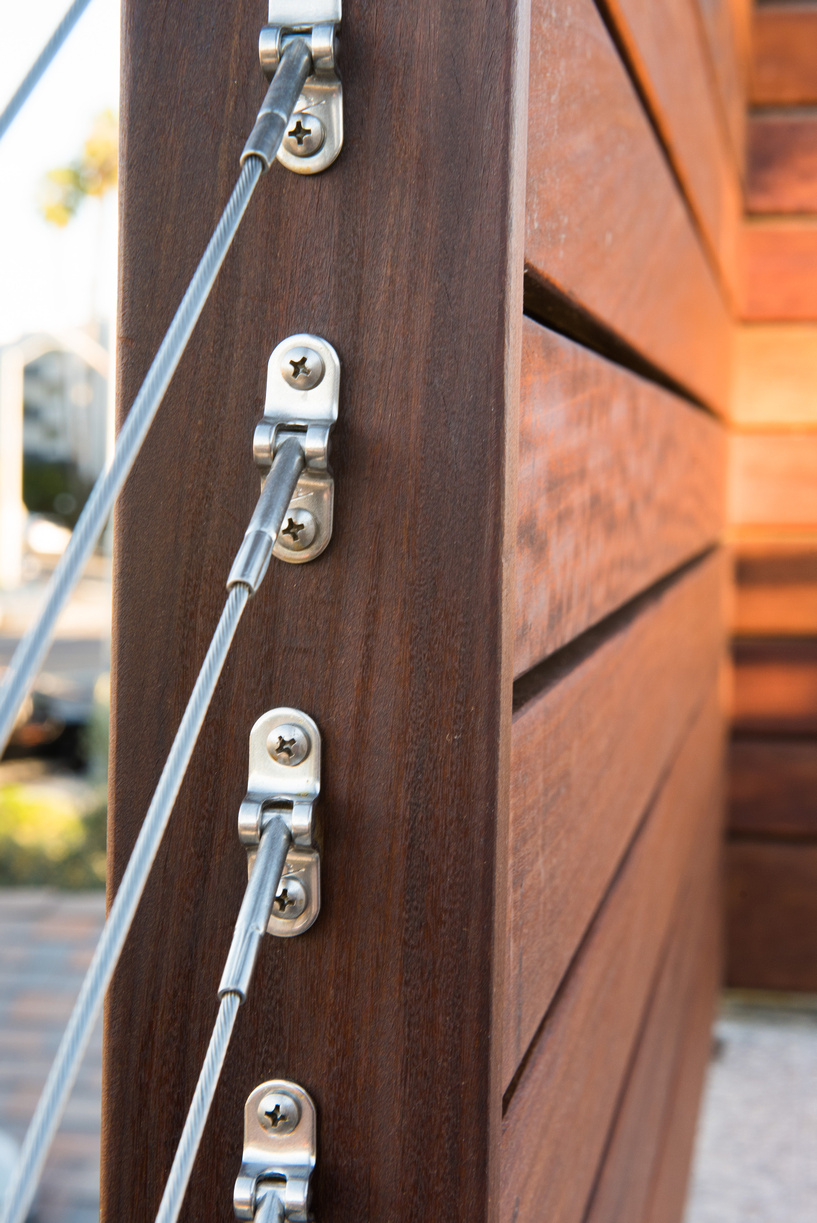
Selecting Wood Timbers for Your Cable Railings There is something special about using natural building products. Choosing wood for a decking project guarantees a unique end result; no two timbers are alike. The variety of colors and grain patterns are endless and the finish options are constantly improving. Here are a few good reasons to consider why wood framed cable railings may be the best choice for your next decking project. Wood Can Be a Cost Effective Way to Construct Decks, Fences and Railings Wood is a great value when it comes to exterior structures, especially decks. Wood is much less expensive than many composite decking products. Wood fences and railings will be much more forgiving than a product like vinyl. Synthetic products change over the years which can make a like for like repair difficult. Most wood timbers do not need to be special ordered or require any lead time to acquire. Wood framed cable railings will typically be less expensive than glass, composite or rod iron railings. Wood is an Ideal Choice for Customization Wood is an excellent choice for cable railings because it is available almost everywhere and it is very easy to use. Most homeowners have a selection of wood tools. Wood can be cut, sanded and fastened by novice carpenters much more easily than steel. When it comes to custom work like building railings, wood will hold it’s lines better than composite products which constantly swell and shrink. With a little imagination you can create a truly custom design by changing timber sizes and profiles. Wood Stays Cooler Wood does not generate or retain heat like composites (plastic) and steel. This is definitely a consideration for daytime deck usage. Lighter colored timbers will hold less heat and also weather well in hot or humid areas. Wood can be a great choice for top railing material, and can be combined with steel or synthetic post options. Natural Beauty With so many beautiful wood species available it’s hard to go wrong. Some of our favorite exterior wood types are Ipe’ and Cumaru which offer dark tones and tight grain patterns. For interior cable railing applications we like to use Oak and Mahogany. Oak is light in color and readily available. It can be stained almost any color to match existing floors or trim work. Mahogany is light brown to red and pink with tight grain patterns and excellent durability.
Structural and Design Considerations for Staircase Renovation Projects A well constructed staircase can serve utilitarian purposes as well as creating a focal point in your home. In some homes, the stairway may be one of the first things that is seen upon entering the house. If you have an older home, your staircase may look weathered; showing it’s age and actually competing with more modern decor. The value of your home should influence your staircase renovation design and decisions. Remodeling a staircase can be an enjoyable project, and it can also generate a great return on investment. Let’s face it; constructing and remodeling stairs can be a challenge. Cutting stringers and calculating angles can be the nemesis of homeowners and contractors alike. Fortunately, our design team and installation pros at SDCR have spent years refining our product line for stairs. Our products are engineered to be user friendly, safe and attractive. Approximately 50% of our railing projects involve stairs. One of the most common interior staircase renovation projects involves removing a bannister wall or pony wall. Removing a bannister wall will open up the space and bring in natural light. Switching from traditional vertical balusters or rod iron pickets and replacing with stainless cable can remove years from the appearance of an older home. Bringing in light and minimizing the amount visual obstructions will make the area appear larger. Tearing out old carpet and installing hardwood or tile stair treads is an excellent way to modernize an older stairway. San Diego Cable Railings offers wooden and steel framing solutions for stairway railings. Stair railing packages are custom made to the specifications of each individual stairway. SDCR railing posts are pre- drilled at the exact angle of each stairway; and welded mounting plates create a strong connection for posts and top rails. Specialty cable hardware allows for pivoting and tensioning of each cable. We have performed some very unique installations over the years and attached stainless cables to all different kinds of framing media. If you have questions about a staircase renovation or railing remodel; give us a call at 844-277-7327 or use the quote request form today!
Easy Installations With DIY Cable Assemblies and Quick Connect Cable Rail Fittings Quick Connect fittings are a simple and cost effective way to install a wide variety of cable railing systems. If you are a do it yourselfer or a contractor that doesn’t want to purchase or use special swaging equipment, self locking cable rail fittings may be the answer. A locking mechanism inside the fitting allows the installer to simply cut the cable and insert it into the fitting. This inner jaw allows the cable to travel only one direction and locking it in the other. The ease of installation provided by these fittings does not sacrifice any connection strength. They are tested up to the breaking strength of the stainless cable which can exceed 1800 lbs. for one 1/8″ strand. This level of strength and safety is unmatched by railing members of standard wood picket and composite balustrade railings. Quick connect cable rail fittings are sleek and attractive and do not require any crimping equipment or special tools. Additionally, if a cable is cut too long, the fittings can be released with a simple tool. Hand crimping cable railing can be effective, however crimping introduces the possibility of bending or damaging a cable rail fitting. It is not the most attractive or the strongest way to attach cable and hardware. All of our stainless steel cable assemblies utilize type 316 marine grade stainless cable for a high level of corrosion resistance. DIY cable assemblies include all of the necessary hardware and instructions for installation. Our cable assembly options offer compatible solutions for deck railings, interior cable railings, stairways, surface mounting, and hardware for both wooden and steel posts. We recommend using an approved stainless steel cable cutter when cutting architectural braided rigid stainless cable. If you have questions about which DIY cable assembly is right for your particular application; call one of our cable railing professionals at 844-277-7327 or use the online quote request.
-A recent cable railing project in Point Loma showcases our “ultra slim” Flat Bar Cable Railing Posts- Amazing views call for transparent railings and adherence to the safety standards that are required for elevated decks. One of our recent coastal cable railing installations provided us with a perfect opportunity to maximize a beautiful skyline view. For this project we were able to offer safety and beauty with a minimalist design using flat bar cable railing posts. Our customer requested a railing that was sleek and modern to compliment his updated hardwood deck and newly remodeled home. In addition, he wanted to preserve as much of the view as possible while minimizing any necessary maintenance. The downtown San Diego backdrop lended itself perfectly to a black powder coated railing frame and stainless steel cables. The gallery photos are a testament to just how transparent a well designed cable railing system can be. SDCR “ultra slim” spreader posts are a step above most industry competition when it comes to intermediate railing posts. Our posts feature a 3/8″ solid stainless steel flat bar that is available in t304 and t316 stainless. The mounting plates utilize a welded connection which is superior to commonly used mechanically fastened plates. Additionally, our posts can be purchased as bare stainless or with a powder coated finish. Flat bar cable railing posts can be used in combination with a variety of other post options and sizes. They will minimize cable spread, maximize views, and provide lateral stability for your railings. San Diego Cable Railings offers preferred installation across California as well as professional engineering packages for permitted project submittals. If you would like to request a quote or ask a question about our flat bar cable railing posts; please visit the quote request page. Many thanks to Phil and kudos to the guys at SD Independent for another beautiful railing installation.

Cable Railing FAQ’S for Fast Estimates and Easy Installations In an effort to assist our customers with the most timely and cost effective cable railing estimates we’ve compiled a few of our most frequently asked questions: Q: Where is SDCR located? Is there a storefront? A: Our production facility is located at 4182 Sorrento Valley Blvd. San Diego, CA 92121. Our storefront is primarily online, however we do meet with some of our customers by appointment. If you would like to speak wth a sales associate about scheduling an appointment, please visit the quote request page or call our office at 844-277-7327. Q: What is the lineal foot cost for cable railing systems? A: Lineal footage cost estimates can vary greatly depending on project sizing, material type/s and the scope of construction. Typically larger exterior projects carry a lower price point than smaller interior projects. Steel framed cable railing systems are usually more costly than project using wood framing members. The quickest way to get an accurate lineal foot cost estimate is by providing photos and measurements to our sales staff. Q: How long does it take to get an estimate? A: Estimates for railing materials and installation are available within 24-48 hours upon receipt of a quote request form. Q: Does San Diego Cable Railings do installations? A: We have a network of cable railing installers serving several counties in California. Currently our network services San Diego, Orange County, Los Angeles, Santa Barbara, San Luis Obispo, San Fransisco and Sacramento metro areas. Our sales staff can provide accurate estimates for all of our cable railing product and installation costs. Q: Do Cable Railing Systems meet building code requirements? A: Yes! Cable Railings have gained popularity and recognition nationwide as a safe and durable option for residential and commercial guardrails. Our company offers engineering packages and connection details for plan submittals, and our installers have participated in building inspections statewide. As with any remodeling project it is important to check your local codes and standards prior to purchasing or installing any railing materials. Q: Does SDCR provide instructions or tech support? A: All of our railing packages include detailed instructions and our staff are available Mon.-Fri. for support calls and technical questions. For additional information and commonly asked questions please visit our FAQ page .
Have a Safe and Happy Thanksgiving Holiday! In observance of Thanksgiving our office will be closed on 11/23 and 11/24/2017. We would like to thank all of our amazing customers, contractors and staff. If you would like to inquire about an estimate or leave us a message, please visit the quote request page and we will return all inquiries on Monday 11/27/17. Thank You All and Happy Turkey Day!